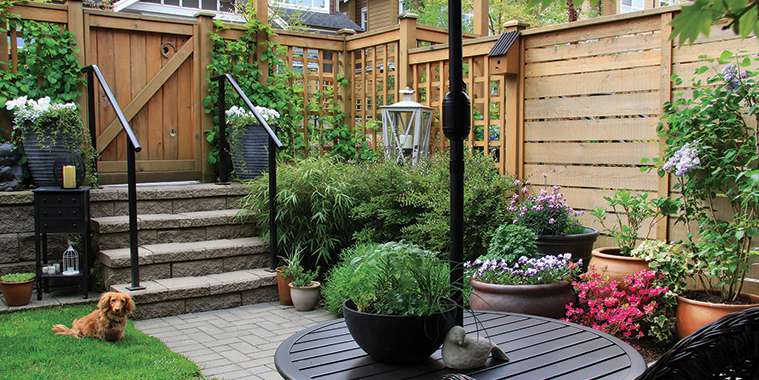A common feature in every neighbourhood, fences can be as varied as their purposes and having a fenced yard holds many benefits.
Whether your desire for a fence is driven by utility, being a good neighbour, or simple aesthetics to increase curb appeal, there is a lot to consider and research before jumping into this investment. Read on as we outline some considerations and weigh the pros and cons of different fence types.
Considerations
Purpose: This first consideration will ultimately establish the type of fence — and budget — you should plan for. Is security or privacy a concern? Do you need to delineate your property’s boundary? Is there a need to create a more private space? Do your children or pets need a secure space to play? If privacy and peace are high on your priority list, plan for a larger budget.
Location and length: Determine where to place your fence and the total length of the perimeter. Double check your deed or survey report if you have one. If anything is in question, speak to a professional surveyor and, if needed, commission a new survey. This is important so you don’t accidentally extend onto a neighbour’s property. Review local regulations in case there are limitations placed on type or height of fencing in your municipality.
Height: If your main purpose is to clearly mark your property’s boundary or provide an enclosed space for your children to play, then a lower fence could suit your purpose. If added privacy, noise reduction or increased security is your aim, then you’d likely want a higher fence.
Materials and costs: Fences can be built using a wide assortment of materials, including chain link, wood, metal, wire, concrete or masonry, vinyl and composite (a combination of wood fibre and vinyl). Pricing varies greatly depending on the type and volume of materials needed for your fence. Pricing can range anywhere from $1,000 for a basic chain link fence, to well over $10,000 for a custom wrought iron fence with gates. If you’re hiring a professional, quotes are usually given per linear foot and pricing will vary based on the requested materials, total fence length and the number of gates.
Types of fences
Whether you wish to have a tall privacy fence, a decorative picket fence or a simple chain link, let’s take a look at the main types of fence materials and their pros and cons.
1. Cedar
Pros: Visually appealing, contains very few knots and is naturally resistant to insects and decay.
Cons: If left untreated, will fade to a silvery grey hue after a few years and is susceptible to rot in the soil. Cedar requires frequent care and maintenance.
Tip: Set your posts into cement to protect the wood from soil and be sure to weather seal the wood every few years. Replace planks when needed to keep your fence looking fresh.
2. Pressure-treated wood
Pros: Economical, resistant to insects, moisture, as well as rot when in direct contact with soil.
Cons: Susceptible to weathering and erosion and has a tendency to warp.
Tip: You can extend the life of your fence by regularly applying a weather sealant to the wood. When selecting this type of wood, choose the straightest planks and replace warped boards as needed.
3. Vinyl
Pros: Durable and long-lasting with very little maintenance once installed. Some vinyl fencing has a lifetime guarantee.
Cons: Requires professional installation, inconsistencies stand out and every part is pre-fabricated, therefore cannot be cut after install.
Tip: Use a mild, eco-friendly soap to wash your fence each spring and rinse off with water to keep it looking bright and new.
4. Composite
Pros: Made from a combination of wood fibre and polymer (similar to MDF, but less dense) to provide a long-lasting and durable wood-like finish.
Cons: Composite is more costly than vinyl and cedar and, like vinyl fencing, must be installed precisely by a professional.
Tip: A simple spray down with water occasionally is all you need to keep this fencing bright and clean.
5. Metal
Pros: Provides versatile options for a range of classic and contemporary designs, with many different eye-catching designs. These are also considered the most durable.
Cons: Metal fence materials and installation can be costly. Wrought iron requires professional installation. They’re typically more decorative than functional – providing minimal added privacy or protection for smaller pets.
Tip: If you prefer to DIY your own fence, consider cast iron, aluminum or steel as they are easier to work with and less expensive than wrought iron.
6. Chain link
Pros: Low-cost solution providing added security for pets, children and to discourage intruders. Chain link can be installed without the help of professionals. Can also act as a trellis when paired with certain plants to help conceal the fence and for added privacy.
Cons: On its own, chain link offers poor privacy and, if uncoated, can rust and corrode over time.
Tip: Consider using vinyl-coated materials to extend the life of your fence and prevent corrosion.
Extras
Once you have the basics down and an idea of budget, it’s time to consider your extras. If you’re going for maximum visual appeal, decorative elements like an arbour or privacy screen might be the perfect addition.
If you enjoy entertaining in your backyard, string lights or integrated solar lights add an eye-catching and functional flair to wow your guests.
Gates are also considered extras and offer both smooth passage and security with integrated locking mechanisms, and come in a wide range of design styles.
If you want to take your fence one step farther, there are seemingly limitless possibilities for unique designs.
Whatever your need, desire or taste, be sure to take your time to thoroughly plan and research the right solution for your budget. Keep an open mind and weigh your options before committing, and you’re sure to be happy with the final results.
— Realtor.ca



